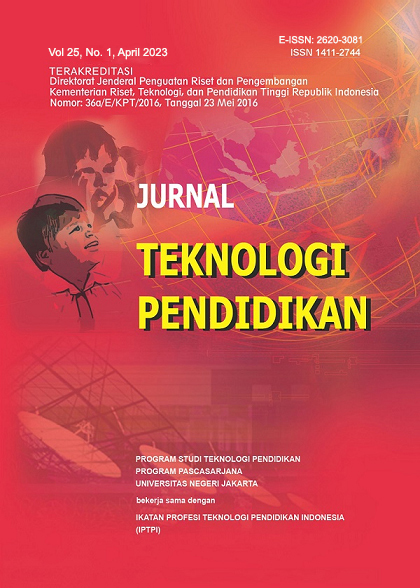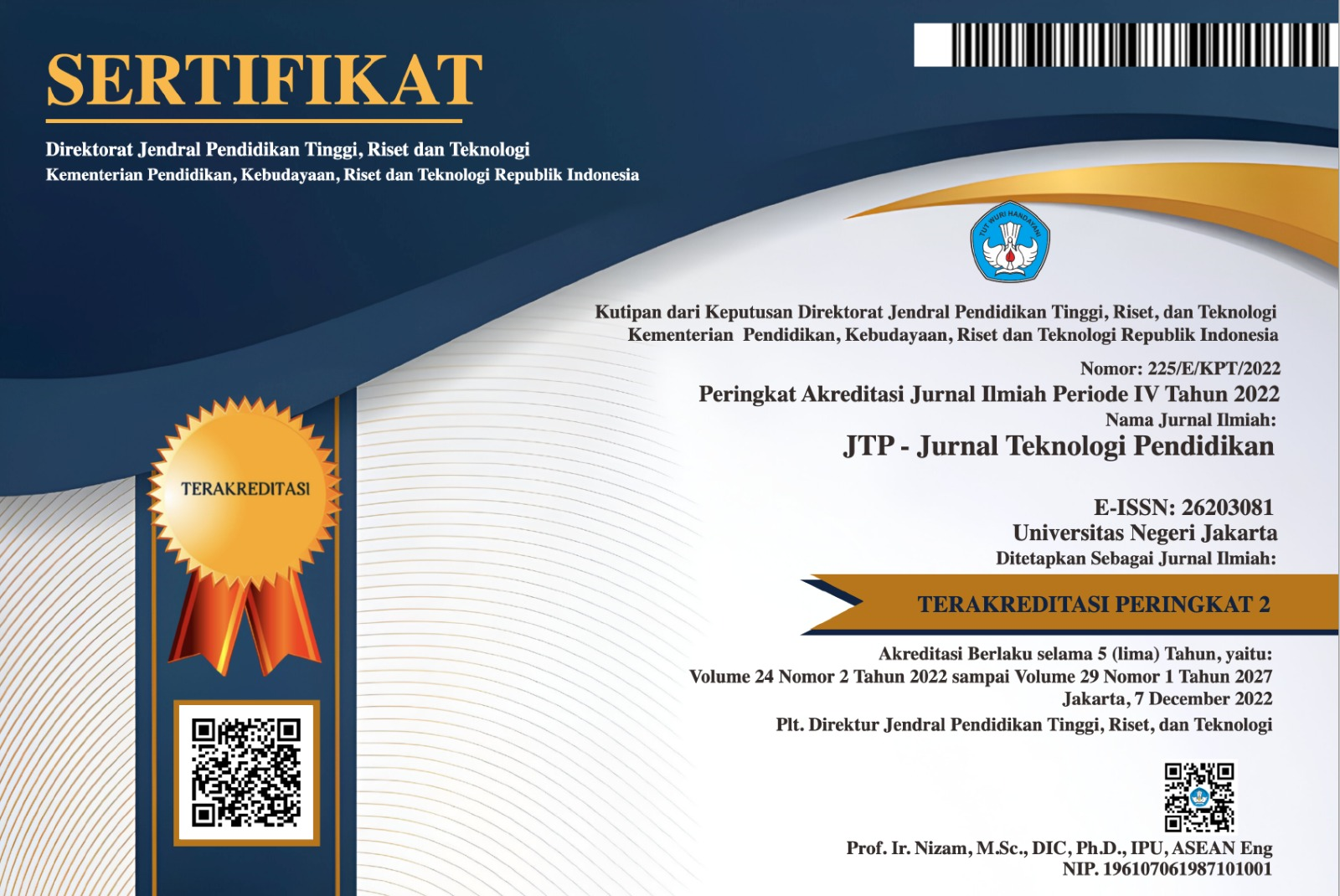Exploring English Learners’ Experiences of Using Mobile Language Learning Applications
Abstrak
Mobile language learning applications provide the potential to transform the way language is learned and it has been used for various purposes including language learning improvement. This investigation will contribute to which applications can support and be appropriate for students in learning English and explore more students’ experiences in using them. This research aimed to explore English learners’ experience of using Mobile Language Learning Applications in an informal learning context. This research employed a descriptive qualitative design with 25 college students. They share their experiences of using Mobile Language Learning Applications to learn English outside the classroom. The instrument used was an interview. The finding of this research showed all the participants confirm that they use mobile language learning to support their learning in English outside the classroom well which involves easy access to the materials, flexible place and time, and sophisticated features of the applications make students explore more and more learning English on the applications and they feel enjoy and fun regulate their learning pattern whenever and where ever, they find progress in learning English after they explore the apps, and students feel free to self-learning with their mobile device. It can be concluded that using Mobile Language Learning Applications outside the classroom allows learners to practice all the areas of English and these applications really supported learners’ experience to learn English based on their needs and self-learning.
Referensi
Agnes, K.-H. (2016). Personalization of language learning through mobile technologies. 0–20.
Alioon, Y. (2017). The effect of authentic m-learning activities on student engagement and motivation. 00(00). https://doi.org/10.1111/bjet.12559.
Almarshadi, A. (2020). The Application Of M-Learning In Improving Speaking Skills. July 2019, 0–15. https://doi.org/10.5281/zenodo.3372503.
Azar, Ali Sorayyaei, and Hassan Nasiri. “Learners’ Attitudes toward the Effectiveness of Mobile Assisted Language Learning (MALL) in L2 Listening Comprehension.” Procedia - Social and Behavioral Sciences, vol. 98, 2014, pp. 1836-1843.
Bamidele, A. (2022). The Use of Mobile Learning to Improve Students ’ Motivation and the Achievement of Learning Outcomes The Use of Mobile Learning to Improve Students ’ Motivation and the Achievement of Learning Outcomes. May 2021.
Beaven, A. (2019). Learning without a teacher. 2021, 43–47. https://doi.org/10.14705/rpnet.2021.50.1234
Ben-Itzhak, S. (2021). On the Varying Effectiveness of Computer/Mobile-Assisted Language Learning. International Journal of Education and Development Using Information and Communication Technology (IJEDICT), 17(3).
Çakmak, F. (2019). Mobile Learning and Mobile Assisted Language Learning in Focus. 2009, 30–48.
Castañeda, Daniel A., and Moon-Heum Cho. (2016). Use of a Game-like Application on a Mobile Device to Improve Accuracy in Conjugating Spanish Verbs.” Computer Assisted Language Learning, vol. 29, no. 7, 2016, pp. 1195-1204.
Creswell, J. W. (2007). Qualitative Inquiry & Research Design (Third Edit). Sage Publication.
Dash, B. B. (2022). Digital Tools for Teaching and Learning English Language in 21 st Century. October. https://doi.org/10.47311/IJOES.2022.4202
Demir, K., & Akpinar, E. (2018). The effect of mobile learning applications on students ’ academic achievement and attitudes toward mobile learning. 6(2), 48–59.
Ekoç, A. (2021). Mobile Language Learning Applications from the Perspectives of Adult Language Learners in Turkey. Shanlax International Journal of Education, 9(4), 259-64.
Farahah, N., Halim, A., Nincarean, D., & Phon, E. (2020). Mobile Learning Application Impact Towards Student Performance in Programming Subject Mobile Learning Application Impact Towards Student Performance in Programming Subject. https://doi.org/10.1088/1757-899X/769/1/012056.
Godwin-Jones, R. 2017. Smartphones and language learning. Language Learning & Technology, 21(2), 3–17. https://scholarspace.manoa. hawaii.edu/bitstream/10125/44607/21_02_emerging.pdf.
Haleem, A., Javaid, M., Asim, M., & Suman, R. (2022). Understanding the role of digital technologies in education : A review. Sustainable Operations and Computers, 3(February), 275–285. https://doi.org/10.1016/j.susoc.2022.05.004.
Hao, Yungwei, et al. “An Evaluative Study of a Mobile Application for Middle School Students Struggling with English Vocabulary Learning.” Computers in Human Behaviour, vol. 95, 2019, pp. 208-216
Hashim, H., Yunus, M., Amin, M., Azwa, N., & Ozir, M. (2017). Sains Humanika Mobile-assisted Language Learning ( MALL ) for ESL Learners : A Review of Affordances and Constraints. 5, 45–50.
Hockly, N. 2013. Mobile learning. ELT Journal, 67(1), 80–84. https://doi.org/10.1093/elt/ccs064.
Hsu, Liwei. (2013) English as a Foreign Language Learners’ Perception of Mobile Assisted Language Learning: A Cross-National Study.” Computer Assisted Language Learning, vol. 26, no. 3, pp. 197-213.
Kamandhari, Helen. 2015. Mobile Language Learning: Challenges and Opportunities for English Language Learning and Teaching.
Kapi Kahbi, A. Y., Osman, N., Ramli, R. Z., & Taib, J. M. (2017). Multimedia education tools for effective teaching and learning. Journal of Telecommunication, Electronic and Computer Engineering, 9(2–8), 143–146.
Kim, H., & Kwon, Y. 2012. Exploring smartphone applications for effective mobile-assisted language learning. Multimedia-Assisted Language Learning, 15(1), 31–57. http://doi.org/10.15702/mall. 2012.15.1.31.
Kukulska-Hulme, A., & Shield, L. 2008. An overview of mobile assisted language learning: From content delivery to supported collaboration and interaction. ReCALL, 20(3), 271–289. https://doi.org/10.1017/S0958344008000335.
Kukulska-Hulme, Agnes. 2009. Will Mobile Learning Change Language Learning?” ReCALL, vol. 21, no. 2, pp. 157-165.
Kukulska-Hulme, Agnes. (2010) Mobile Learning as a Catalyst for Change.” Open Learning: The Journal of Open, Distance and e-Learning, vol. 25, no. 3, pp. 181-185.
Lai, C., & Zheng, D. (2018). Self-directed use of mobile devices for language learning beyond the classroom. ReCALL, 30(3), 299–318. https://doi.org/10.1017/S0958344017000258
Lee, K. (2017). Rethinking the accessibility of online higher education: A historical review. Internet and Higher Education, 33, 15–23. https://doi.org/10.1016/j.iheduc.2017.01.001
Loeng, S. (2020). Self-Directed Learning : A Core Concept in Adult Education Self-Directed Learning : A Core Concept in Adult Education. August. https://doi.org/10.1155/2020/3816132.
Miangah, T. M., & Nezarat, A. (2012). Mobile-assisted language learning. International Journal of Distributed and Parallel Systems, 3(1), 309–319. https://pdfs.semanticscholar.org/2902/cf4ef0284cb 407e986ec2cbed96c7ddbfeb8.pdf.
Mudin, D. K. D., Eng, H. S., Rahman, M., Ibrahim, P., & Jopony, M. (2018). Industrial revolution 4 . 0 : Universiti Malaysia Sabah perspective. 03005, 3–6
Pareja-Lora, Antonio, et al. 2013. Toward Mobile Assisted Language Learning Apps for Professionals that Integrate Learning into the Daily Routine.” 20 Years of Eurocall: Learning from the Past, Looking to the Future, edited by L. Bradley and S. Thouësny, pp. 206-210.
Park, S. Y., Nam, M. W. & Cha, S. B. 2011. University students' behavioural intention to use mobile learning: Evaluating the technology acceptance model. British Journal of Educational Technology. http://dx.doi.org/10.1111/j.1467- 8535.2011.01229. [December 2014].
Polakova, P. (2022). Vocabulary Mobile Learning Application in Blended English Language Learning. 13(May). https://doi.org/10.3389/fpsyg.2022.869055
Rafiq, K. R. M., Hashim, H., Yunus, M., & Norman, H. (2020). ìSPEAK : Using Mobile-Based Online Learning Course to Learn ‘ English for the Workplace.’ 14(8), 19–31.
Rahamat, R. B., Shah, P. M., Din, R. B., Bt, J., & Aziz, A. (2018). Students ’ Readiness And Perceptions Towards Using Mobile Technologies For Learning The Rashidah Bt Rahamat. XL, 69–84.
Rosell-Aguilar, Fernando. 2016. User Evaluation of Language Learning Mobile Applications: A Case Study with Learners of Spanish.” The International Handbook of Mobile-Assisted Language Learning, edited by Agnieszka Palalas, and Mohamed Ally, Central Radio & TV University Press, pp. 545–581.
Sari, M. I., & Sari, M. I. (2019). The Use of Web 2 . 0 Tools for Learning in EFL. 4(2).
Savill-smith, C. (2004). Mobile learning anytime everywhere Mobile learning anytime everywhere.
Sipra, M. A., & Ahmad, W. (2016). Impact of Mobile Assisted Language Learning ( MALL ) on EFL : A Meta-Analysis. 7(2). https://doi.org/10.7575/aiac.alls.v.7n.2p.76
Tonekaboni, A. M. (2019). Effects of Mobile Assisted Language Learning (MALL) on Speaking Proficiency (A case of Learn English Daily Mobile App). 2nd International Conference on Advanced Research in Humanities and Art., May 2019, 1–13.
Update, T. P. (2017). Reimagining the Role of Technology in Education : January.
Wang, Yen-Hui. 2017. Integrating Self-Paced Mobile Learning into Language Instruction: Impact on Reading Comprehension and Learner Satisfaction.” Interactive Learning Environments, vol. 25, no. 3, pp. 397- 411.
##submission.copyrightStatement##
##submission.license.cc.by-sa4.footer##Jurnal Teknologi Pendidikan is an Open Access Journal. The authors who publish the manuscript in Jurnal Teknologi Pendidikan agree to the following terms.
Attribution-ShareAlike 4.0 International (CC BY-SA 4.0)
-
Attribution — You must give appropriate credit, provide a link to the license, and indicate if changes were made. You may do so in any reasonable manner, but not in any way that suggests the licensor endorses you or your use.
-
ShareAlike — If you remix, transform, or build upon the material, you must distribute your contributions under the same license as the original.
- No additional restrictions — You may not apply legal terms or technological measures that legally restrict others from doing anything the license permits.
Notices:
- You do not have to comply with the license for elements of the material in the public domain or where your use is permitted by an applicable exception or limitation.
- No warranties are given. The license may not give you all of the permissions necessary for your intended use. For example, other rights such as publicity, privacy, or moral rights may limit how you use the material.








